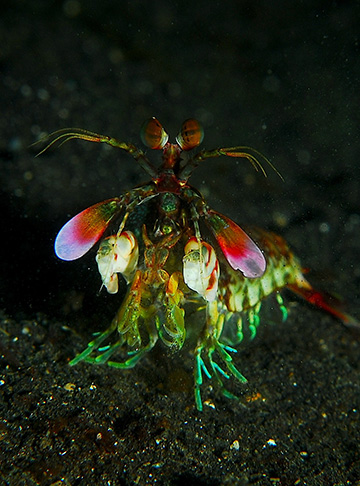
Front view of mantis shrimp. [Image: Wikipedia]
Scientists have investigated the complex visual capabilities of mantis shrimp for their ultraviolet detection, their polarization-based signaling and even their larvae’s camouflaged eyes. Now the stomatopod’s stunning sight has inspired a new camera that records both color and polarization imaging data with a single chip (Optica, doi:10.1364/OPTICA.4.001263).
Research team members based at two Midwestern U.S. universities say that their camera could enable real-time underwater studies of marine animals that communicate through multispectral channels—and that it also may have applications in biomedical imaging.
Mimicking a compound eye
Lead investigators Missael Garcia, a graduate student at Washington University in St. Louis (WUSTL), and Viktor Gruev, a professor at the University of Illinois, arranged their camera’s optical components to mimic the light path through a single ommatidium – the simplest working unit of a mantis shrimp’s compound eye. For example, light enters the shrimp’s ommatidium through a crystalline cone that acts as a ultraviolet filter; signals enter the bio-inspired camera through a lens system incorporating UV and near-infrared filters.
In the midsection of each ommatidium, within the side (peripheral) regions of the compound eye, tiny alternating stacks of microvilli, or tiny tubes, allow the shrimp to perceive linearly polarized light. In the midband (central region) of the eye, a vertical stack of light-detecting and filtering cells senses color. The deepest cells detect the longest wavelengths of light; the cells at shallower depths pick up the shortest wavelengths.
Likewise, the shrimp-mimicking camera incorporates two pairs of nanowire linear-polarization filters, offset 45 degrees from each other. Beyond these filters, three epitaxially grown, vertically stacked photodetectors take advantage of silicon’s wavelength-dependent absorption coefficient: the layers are optimized, top to bottom, for blue, green and red light.
The camera takes 1280×720-px images, with better than 30 percent quantum efficiency in the visible spectrum and high polarization extinction ratios. After testing the camera out in the laboratory, the researchers mounted it in an underwater housing and took video, in full-color visible and false-color polarized light, of several marine crustaceans and fish off the coast of Australia.
